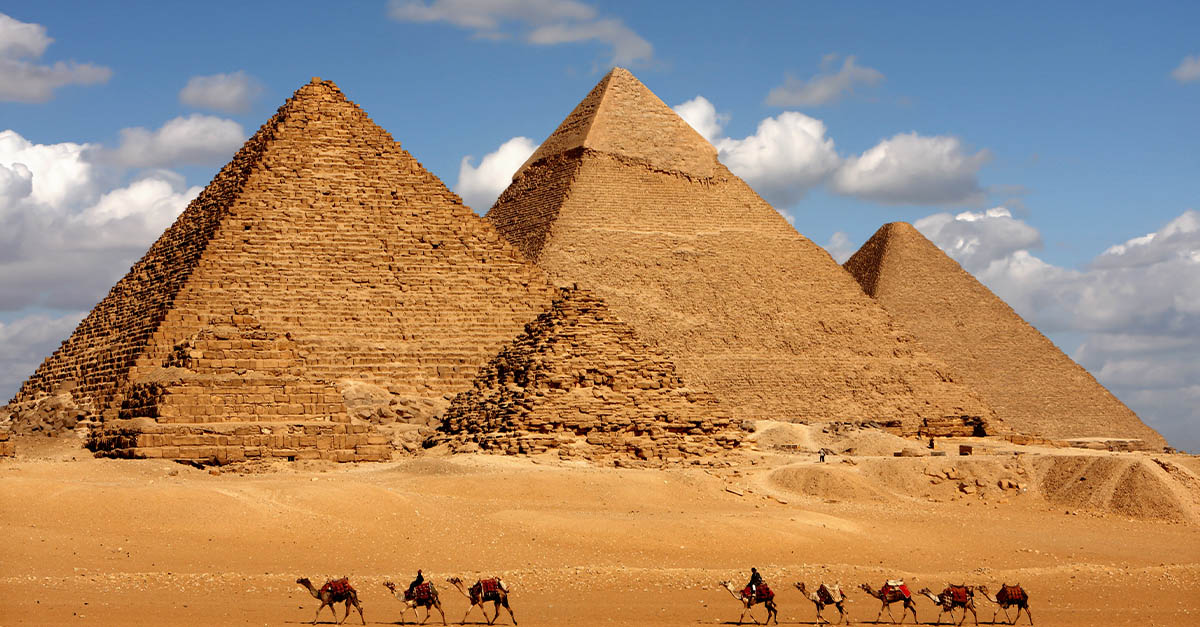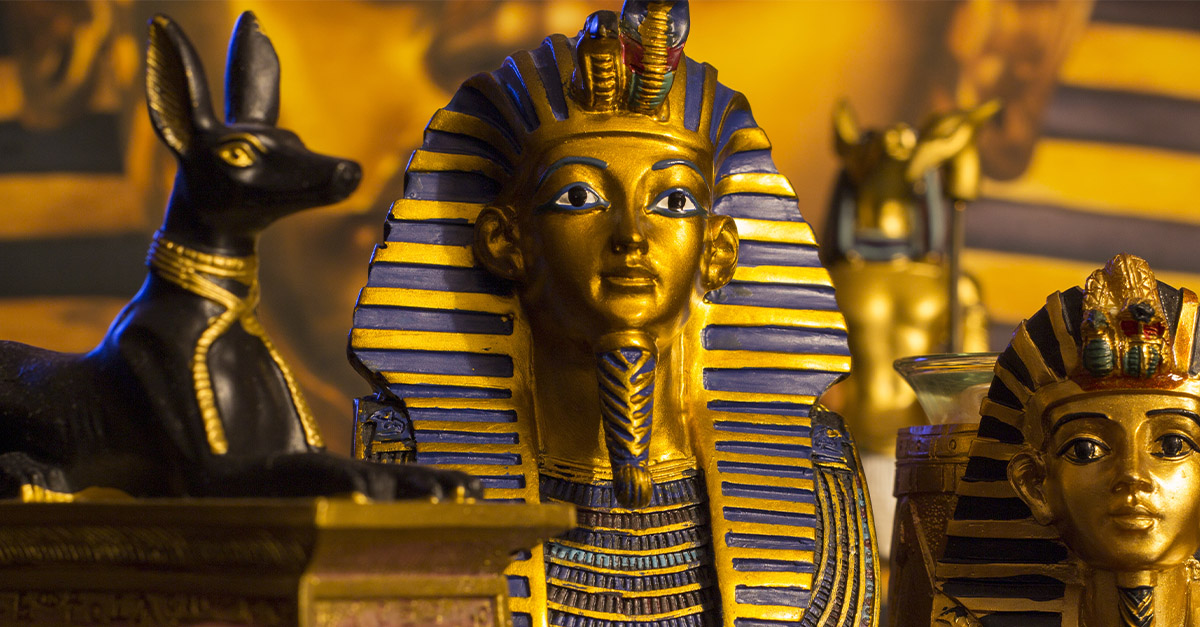Ancient Wonders
Egypt’s Pyramids of Giza are wonders of the ancient world—and today. The awesome structures attract millions of tourists from all over the world each year. Gazing at the ancient monuments never fails to raise the question: How exactly were they built? Let’s review the facts and theories of how the Egyptians built the pyramids.
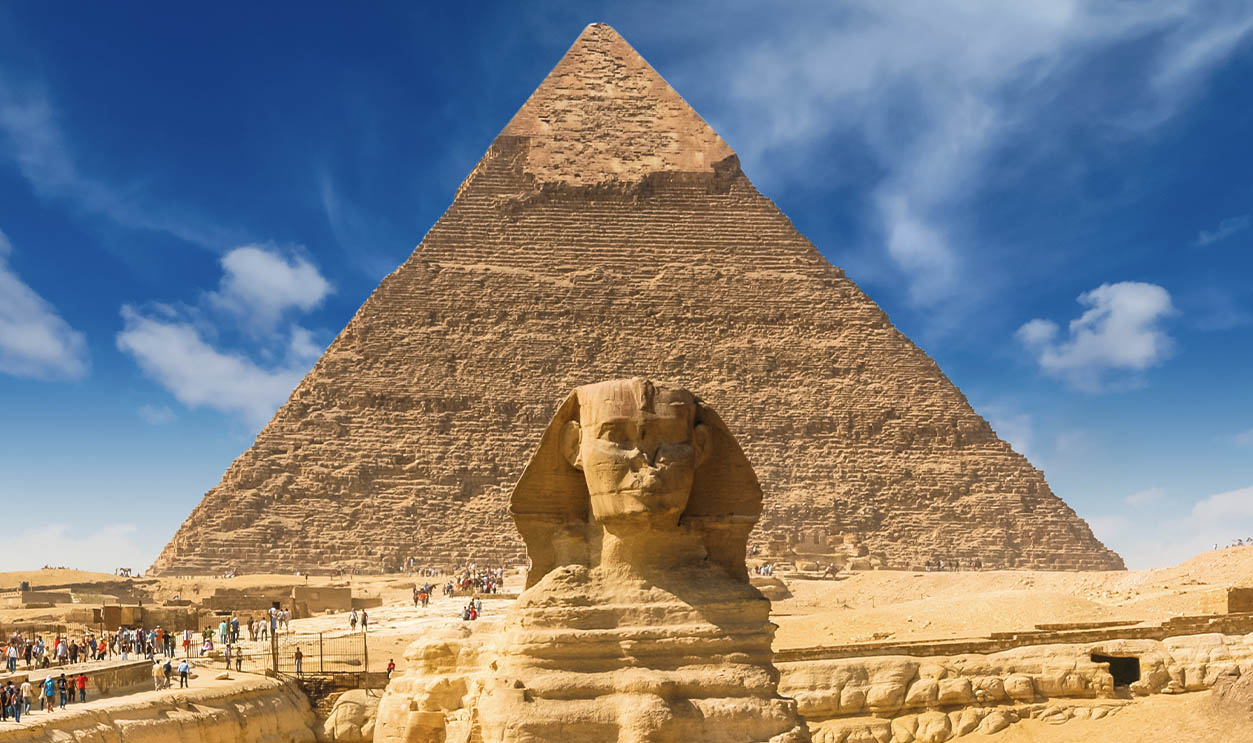
Pyramid Facts: The Basics
The three pyramids at Giza were built around 2600 BC as tombs of the Fourth Dynasty pharaohs. The Great Pyramid of Khufu’s height of 481 feet made it the tallest human-made structure on Earth until it was surpassed by Lincoln Cathedral in England in the 14th Century.
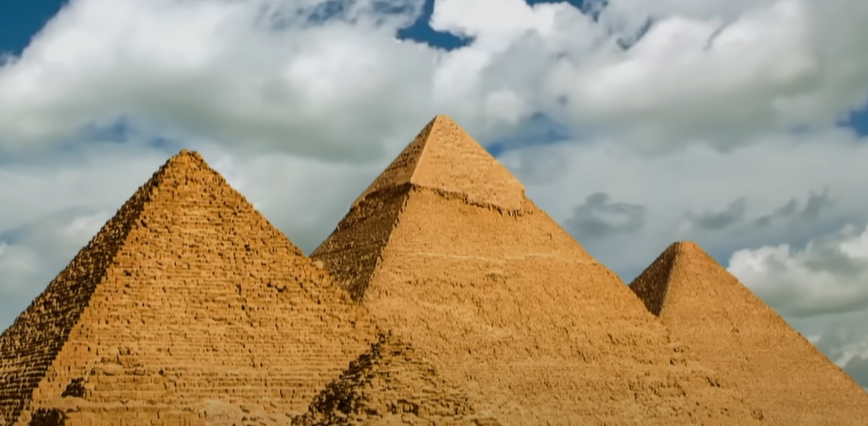 PBS, NOVA, Decoding the Great Pyramid (2019)
PBS, NOVA, Decoding the Great Pyramid (2019)
Pyramid Facts: Running The Numbers
The Great Pyramid’s sides are 756 feet at their base. The sides slope at about 52 degrees. Covering more than 13 acres, the Great Pyramid required almost 600,000 stone blocks for its core and another 40,000 casing stones for the smooth exterior surfaces.
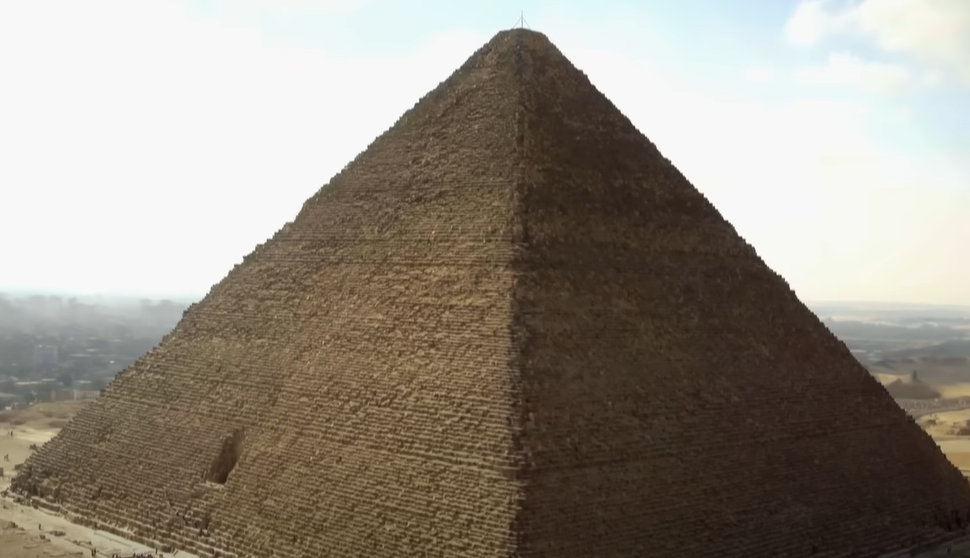 PBS, NOVA, Decoding the Great Pyramid (2019)
PBS, NOVA, Decoding the Great Pyramid (2019)
Pyramid Internal Features
Almost all pyramids contain internal passageways and burial chambers below ground level. The Great Pyramid is unique in that its King’s Burial Chamber is well above ground level, accessed by a long high-ceilinged passage called the Grand Gallery. The King’s chamber also has two air passages angled upward. The internal structure of the Great Pyramid is important as it offers potential clues about construction methods.
 Jon Bodsworth, Wikimedia Commons
Jon Bodsworth, Wikimedia Commons
Pyramid Building Materials: Structural Stones
The bulk of the stones that make up the pyramids were limestone blocks of an average weight of over two tons. These blocks were cut from a quarry that is still visible today in the area immediately to the south of the pyramids. Research shows that the ancient Egyptians took advantage of the existing natural fracture patterns in the limestone to aid in their extraction.
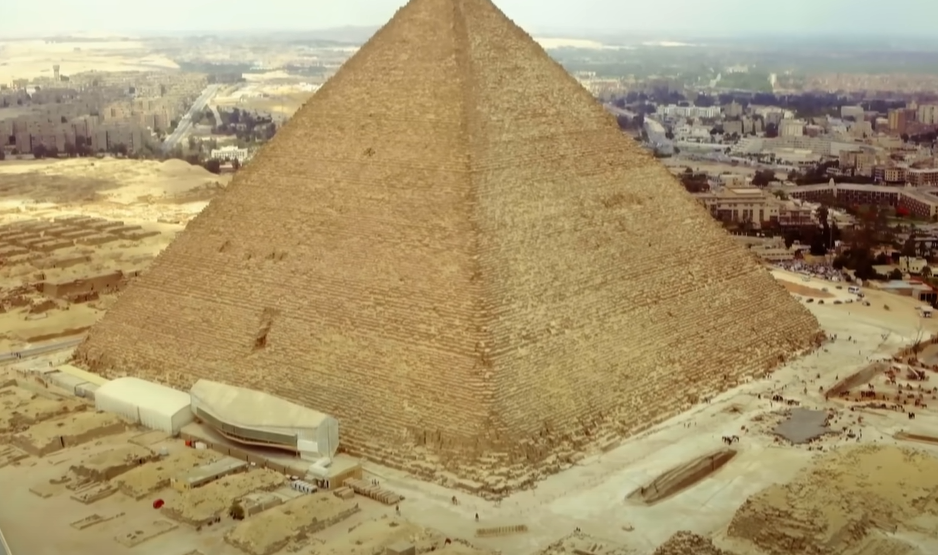 PBS, NOVA, Decoding the Great Pyramid (2019)
PBS, NOVA, Decoding the Great Pyramid (2019)
Pyramid Building Materials: Casing Stones
The pyramids were originally smooth, faced with carefully cut blocks of a higher quality white limestone. These casing stones were cut from the Tura quarry on the eastern bank of the Nile, about 15 kilometers from the pyramids. There is a section of casing stones still visible in the upper section of the Khafre pyramid, which provides a clue to the pyramids’ original splendor.
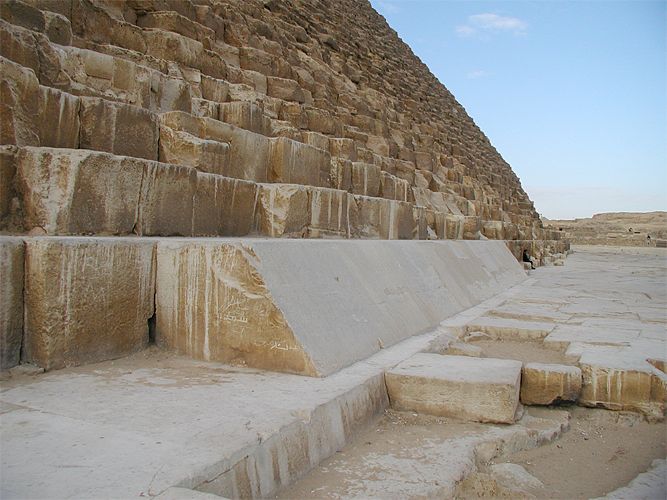 Jon Bodsworth, Wikimedia Commons
Jon Bodsworth, Wikimedia Commons
Pyramid Building Materials: Granite
The interior passageways, tombs, and sarcophagi of the pharaohs were constructed of larger, heavier slabs of granite. How much heavier? Some of the slabs weigh 80 tons! The granite was mostly quarried from the vicinity of Aswan, more than a thousand kilometers up the Nile. Workers floated these larger rocks down the Nile on barges until they reached the pyramid construction site.
 PBS, NOVA, Decoding the Great Pyramid (2019)
PBS, NOVA, Decoding the Great Pyramid (2019)
Pyramid Building Materials: Mortar
Mortar was the glue that held the stones together and kept them evenly distributed through the structure. The Egyptians used two mortars in the pyramids: lime (crushed limestone) mixed with water and sand; and a quick-setting mortar made of crushed gypsum and water. These mortars were a triumph of engineering for their weather-resistant and adhesive properties.
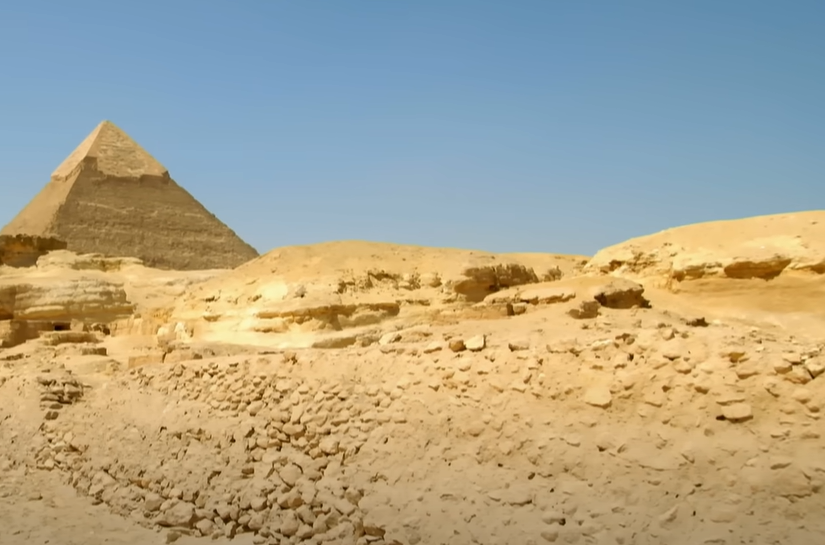 PBS, NOVA, Decoding the Great Pyramid (2019)
PBS, NOVA, Decoding the Great Pyramid (2019)
Pyramid Building Equipment: Wood
Wood was mostly used to construct sledges to transport the quarried blocks along the ground. Wooden beams and wedges were also used to force open cracks in the rock during the quarrying process. Wood was hard to come by in the arid Egyptian landscape and would have required transport from the forests of Lebanon.
 PBS, NOVA, Decoding the Great Pyramid (2019)
PBS, NOVA, Decoding the Great Pyramid (2019)

History's most fascinating stories and darkest secrets, delivered to your inbox daily.
Pyramid Building Equipment: Rope
Rope was a critical piece of equipment for building pyramids. Dragging stone blocks out of quarries, along level ground and up ramps onto the emerging pyramid would have required immense amounts of the stuff. Fortunately, the Egyptians made excellent rope from papyrus fibers. Used to lower sarcophagi into crypts and haul heavy rocks around, there is no doubt about the reliability of Egyptian papyrus rope.
 PBS, NOVA, Decoding the Great Pyramid (2019)
PBS, NOVA, Decoding the Great Pyramid (2019)
Pyramid Building Equipment: Copper Tools
Workers used metal chisels to quarry and shape the stone blocks. As iron hadn’t been developed yet, all the chisels and sawing implements were tipped by copper or copper alloy. The soft metal would require constant re-sharpening when hewing through the limestone. As for the granite slabs used in the complex interior features of the pyramid, a harder material was required.
 PBS, NOVA, Decoding the Great Pyramid (2019)
PBS, NOVA, Decoding the Great Pyramid (2019)
Pyramid Building Equipment: Dolerite Rock
The granite rock at the Aswan quarry site on the Nile would have been far too hard to extract using copper chisels. Instead, research has shown that stonemasons used pieces of a hard igneous rock called dolerite. Hand pounding with dolerite rocks formed the granite slab’s rough dimensions. The edges and surfaces could then be smoothed off using quartz sand abrasion.
 PBS, NOVA, Decoding the Great Pyramid (2019)
PBS, NOVA, Decoding the Great Pyramid (2019)
Did The Egyptians Have Pulleys?
Most researchers agree that the Egyptians knew about pulley systems to lift the blocks. The problem was that they didn’t have strong enough materials to make a pulley that wouldn’t break under the immense weight of the stones. There is evidence that the Egyptians used levers capable of lifting the huge rocks with the help of shims, but there’s no hard evidence that levers were used on the pyramids.
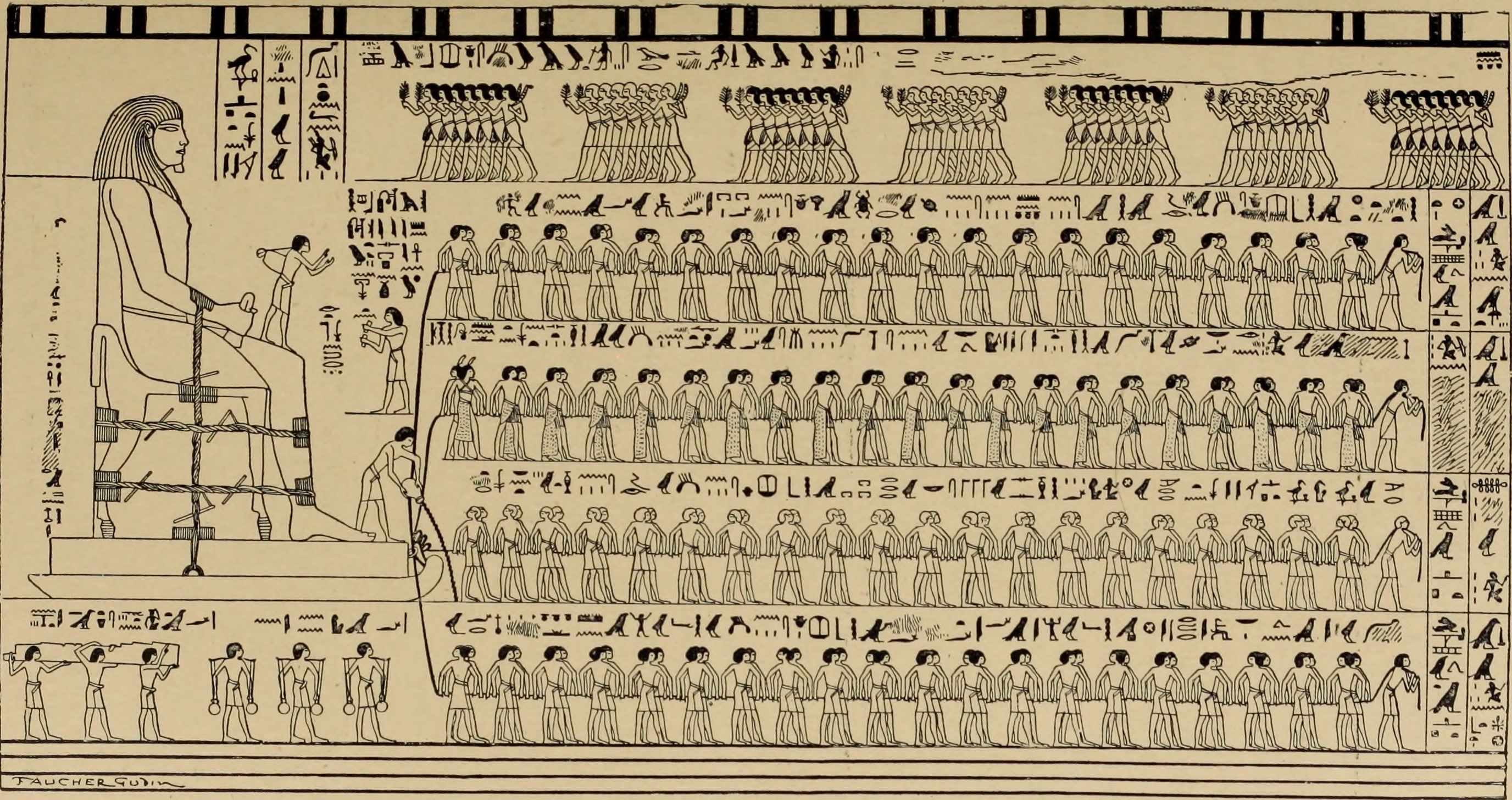 Internet Archive Book Images, Wikimedia Commons
Internet Archive Book Images, Wikimedia Commons
Pyramid Work Force: An Army Of Slaves?
The use of vast numbers of slaves to build the pyramids is a common belief that may have come from the Old Testament’s Book of Exodus. The ancient Greek historian Herodotus also wrote of an army of 100,000 slaves who constructed the Great Pyramid. Depictions from films such as The Ten Commandments (1956) and Exodus: Gods and Kings (2014) have added to the confusion—however, an important discovery in the 1980s put the slave theory to rest.
 Chernin Entertainment, Exodus: Gods and Kings (2014)
Chernin Entertainment, Exodus: Gods and Kings (2014)
Pyramid Work Force: A Worker’s Village
The unearthing of a workers’ village complex in1988 changed the view of the quality and quantity of workers building the pyramids. Archaeologists excavated a site known as Heit al-Ghurab, known as the Lost City Of The Pyramids, which included houses magazines, three main streets, and a royal administrative building. The discovery of a workers’ cemetery nearby gave further clues to the social class of the pyramid workers, who are now believed to be skilled tradesmen and artisans, well-paid for a highly sought-after job. The barracks at the site are estimated to have hosted a maximum of 5,000 workers at any one time.
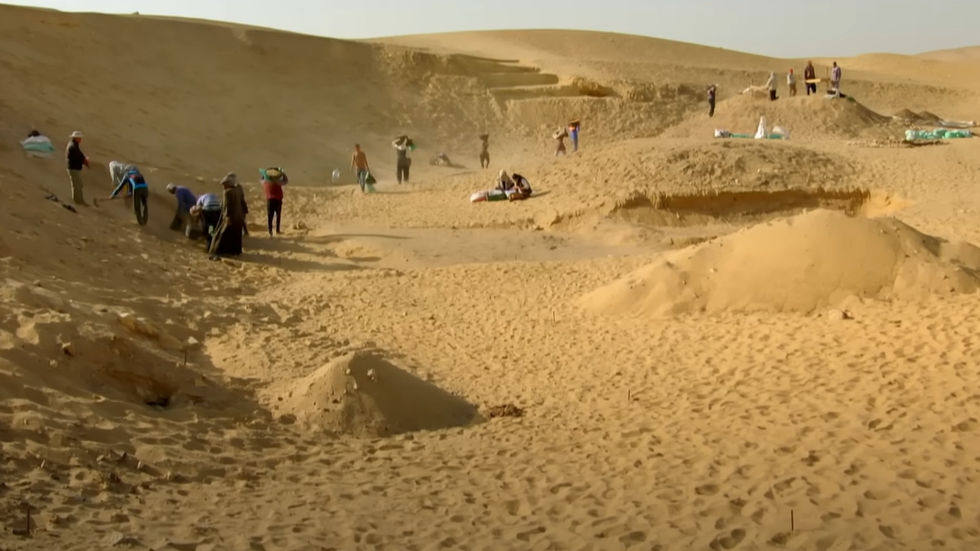 PBS, NOVA, Decoding the Great Pyramid (2019)
PBS, NOVA, Decoding the Great Pyramid (2019)
A Worker’s Diary Is Discovered
A papyrus scroll from the time of the building of the pyramids was found in 2013 at a site near the Red Sea. Known as the Diary of Merer, the papyrus describes the shipping of rocks to the pyramid building site, and mentions by name the project manager of the pyramid construction. It is further evidence of the skill and intelligence of the workforce building the pyramids.
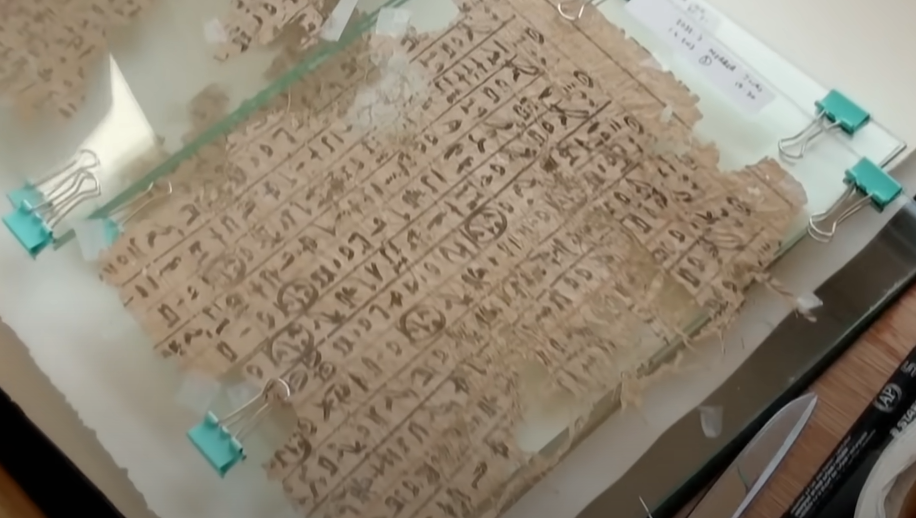 PBS, NOVA, Decoding the Great Pyramid (2019)
PBS, NOVA, Decoding the Great Pyramid (2019)
Water For Faster Stone Cutting
The waters of the Nile have always been the lifeblood of Egyptian civilization, and played a crucial role in the construction of the pyramids as well. To cut rock faster, workers poured water into the cutting surfaces. Not only did this lubricate the cutting and chiseling, but it dissolved salts in the rock itself to weaken it further. This was especially important for cutting the harder rock types like granite.
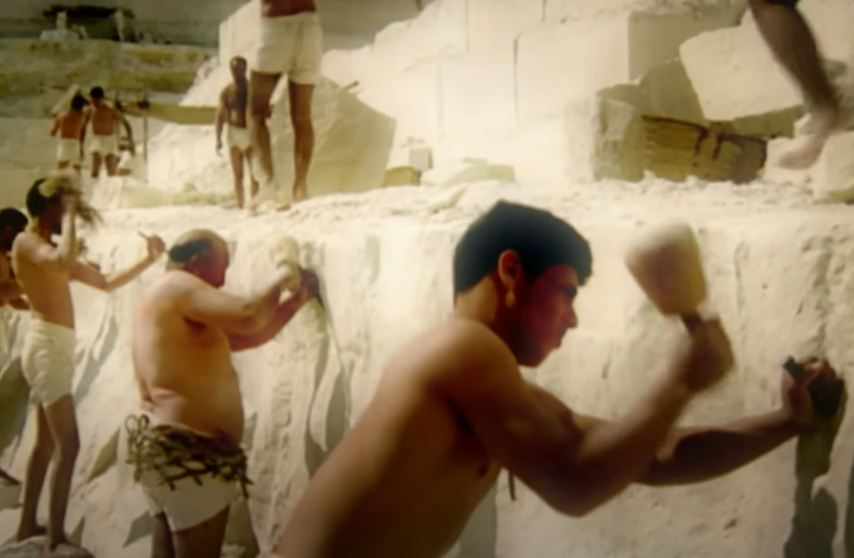 PBS, NOVA, Decoding the Great Pyramid (2019)
PBS, NOVA, Decoding the Great Pyramid (2019)
Water To Help Move Blocks
The movement of the quarried stones was done by sliding them on wooden sledges pulled by ropes. Water was sprayed onto the ground in front of the sledge, which made it much faster and easier to pull the giant sections of rock along.
 PBS, NOVA, Decoding the Great Pyramid (2019)
PBS, NOVA, Decoding the Great Pyramid (2019)
The Role Of The Nile
Researchers have always wondered about the exact role that the Nile River itself played in the building of the pyramids. It is now commonly accepted that granite blocks were transported from far upstream on the Nile, and that the limestone casing blocks were transported from the other side of the Nile to the pyramids.
 PBS, NOVA, Decoding the Great Pyramid (2019)
PBS, NOVA, Decoding the Great Pyramid (2019)
A Harbor For Offloading Materials
Testing in 2024 using modern techniques revealed a lost branch of the Nile, the Ahramat, that approached quite near the Giza Plateau. There are causeways between the pyramid and the vanished river channel along with other human-made structures that would have been part of a harbor facility. This harbor would have greatly eased the transport of workers, stones, and other supplies for the project.
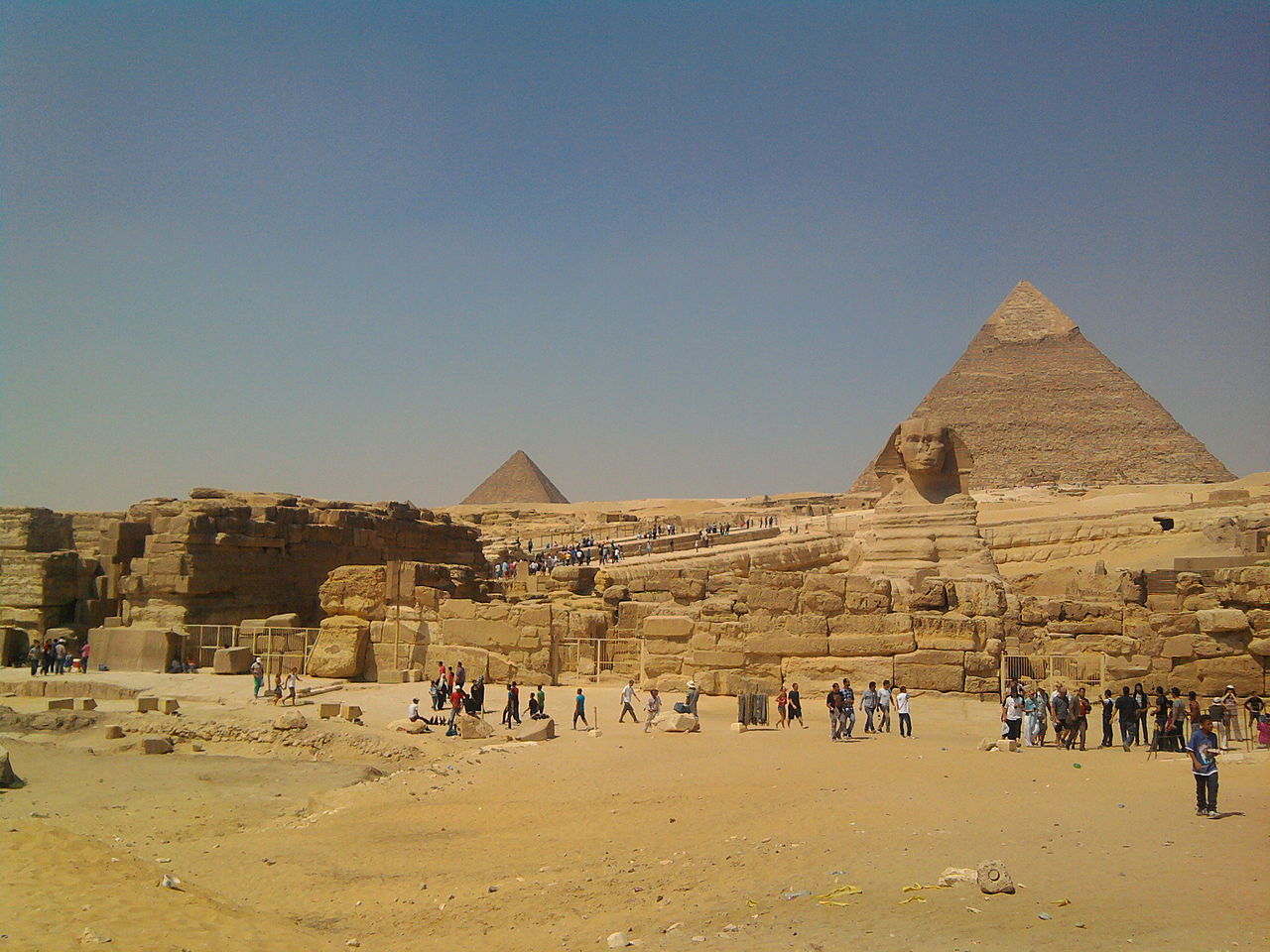 Johnny 201, CC BY-SA 3.0, Wikimedia Commons
Johnny 201, CC BY-SA 3.0, Wikimedia Commons
Alignment
The pyramids were carefully aligned to the four points of the compass. The Egyptians most likely accomplished this task with the use of their surveying tool, the merkhet. Astronomical calculations and correlation with other monuments in Egypt suggest that the pyramids were aligned to stars that were rotating the celestial North Pole at the time of construction.
 PBS, NOVA, Decoding the Great Pyramid (2019)
PBS, NOVA, Decoding the Great Pyramid (2019)
Pyramid Construction: Laying The Foundation
Ancient Egyptian work crews prepared the ground carefully in order to make the structure as stable as possible. For many years, the theory was that the Egyptians filled several trenches with water and smoothed everything down to the water’s level. But like almost every aspect of pyramid construction, there are alternative explanations.
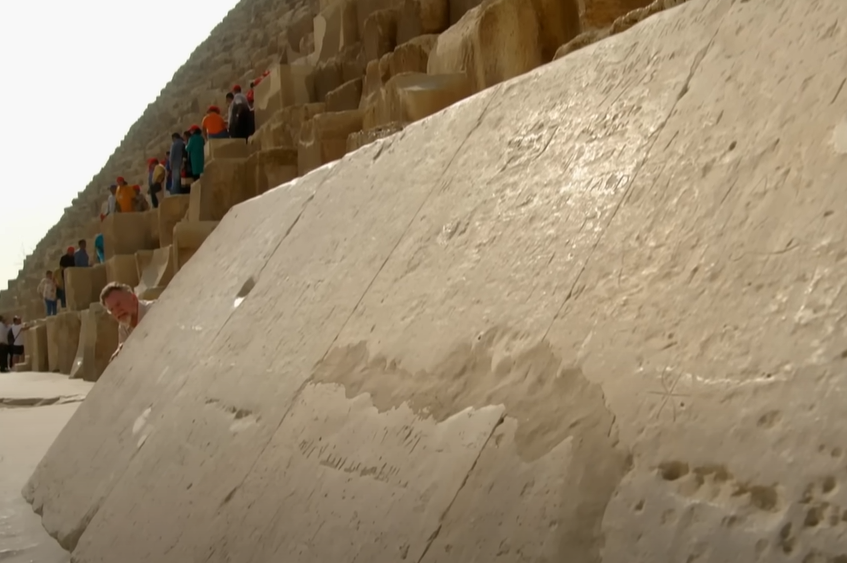 PBS, NOVA, Decoding the Great Pyramid (2019)
PBS, NOVA, Decoding the Great Pyramid (2019)
Laying The Foundation: A More Recent Interpretation
Meticulous mapping of the Giza Plateau carried out since the 1980s suggests that the Egyptians didn’t level off the entire foundation area, but only surveyed the pyramid’s four edges to make sure they were perfectly horizontal.
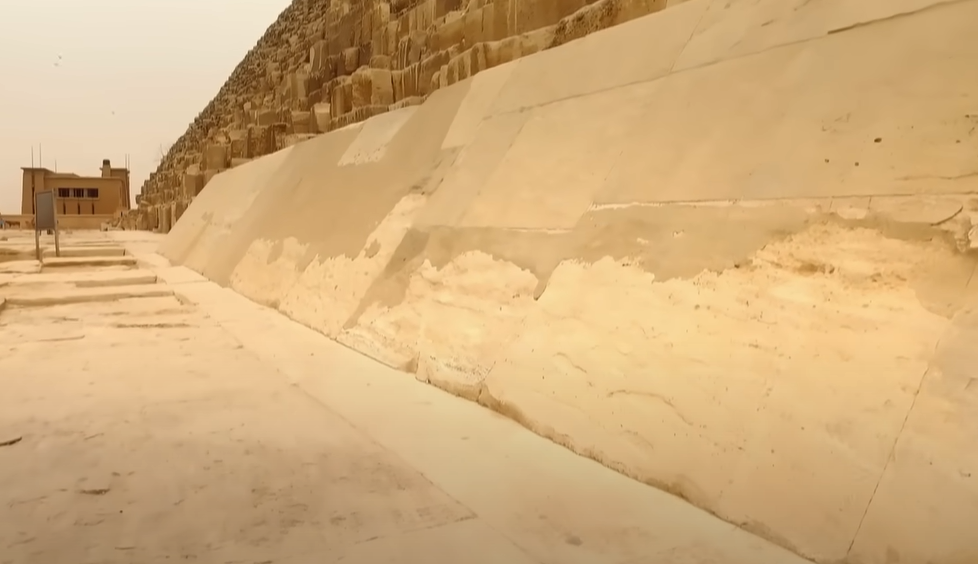 PBS, NOVA, Decoding the Great Pyramid (2019)
PBS, NOVA, Decoding the Great Pyramid (2019)
Anchoring The Cornerstones
The cornerstones are further evidence of ancient Egyptian foresight and ingenuity. The cornerstones were of a ball and socket design, that is, implanted deeper into the ground to prevent shifting due to earthquakes or other ground disturbances.
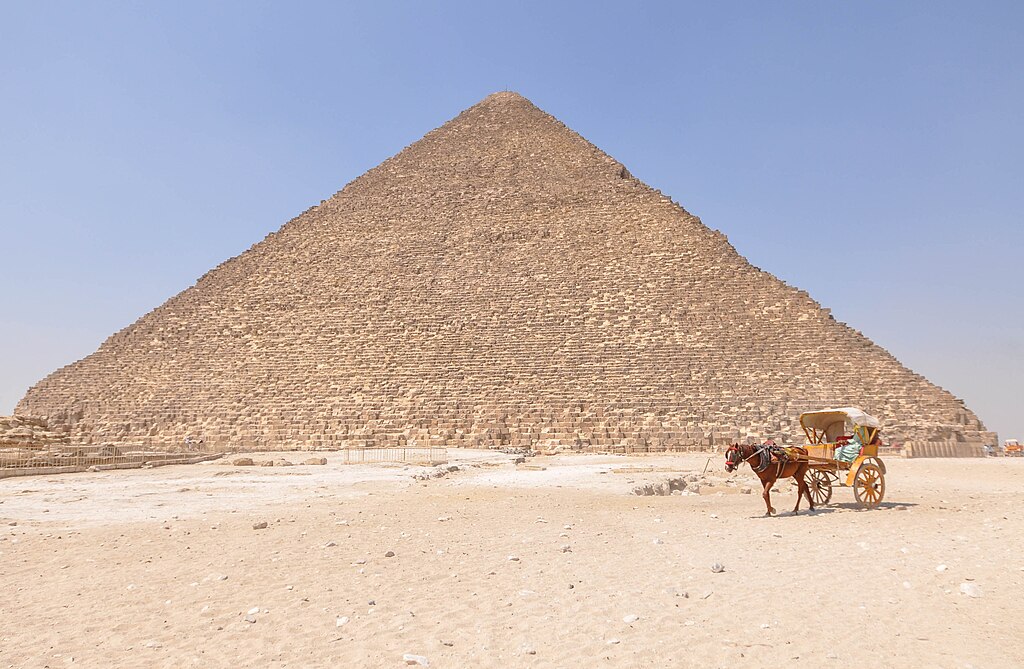 Jorge Láscar, CC BY 2.0, Wikimedia Commons
Jorge Láscar, CC BY 2.0, Wikimedia Commons
Installing The Casing Stones
A study of the still-existing casing stones on the Khafre pyramid shows a method to their installation. It appears that each row of casing stone was started simultaneously at both ends by separate teams of workers. The two sections were joined together in the middle by shorter stones called bonding stones with tapered sides that could be dropped easily into place.
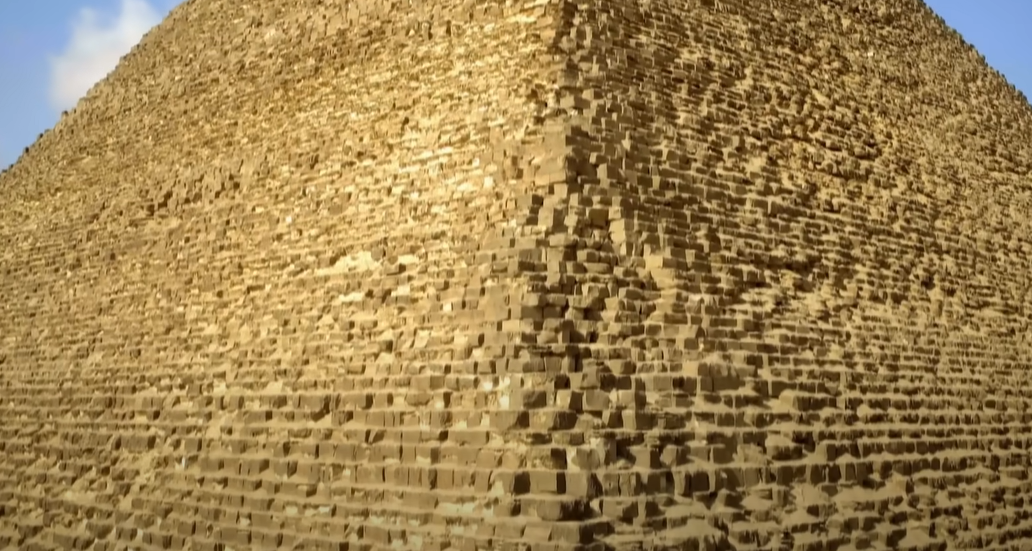 PBS, NOVA, Decoding the Great Pyramid (2019)
PBS, NOVA, Decoding the Great Pyramid (2019)
The Capstone
A pointed capstone was the finishing touch of the pyramid’s construction. It’s speculated that the original capstone for the Great Pyramid was originally coated with gold leaf. If that was the case, it’s no surprise that it was already gone by the time of the Romans, leaving the empty platform at the pyramid’s peak that we still see today.
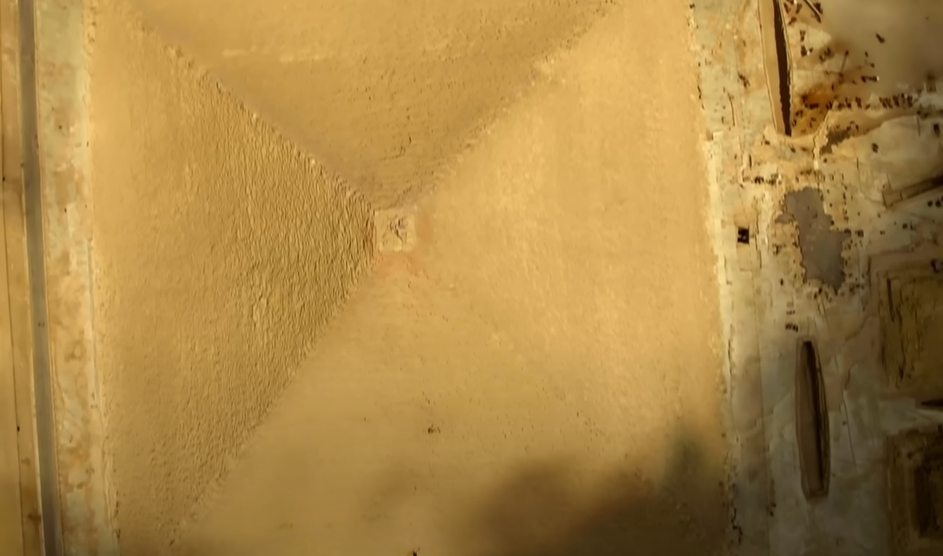 PBS, NOVA, Decoding the Great Pyramid (2019)
PBS, NOVA, Decoding the Great Pyramid (2019)
Building The Perfect Ramp
Researchers are unanimous that some kind of ramp was used to drag the blocks up to where they would be installed on the pyramid. But there is no agreement on the ramp’s exact configuration. Every ramp design under consideration has drawbacks, and there are some strict criteria that a ramp has to meet.
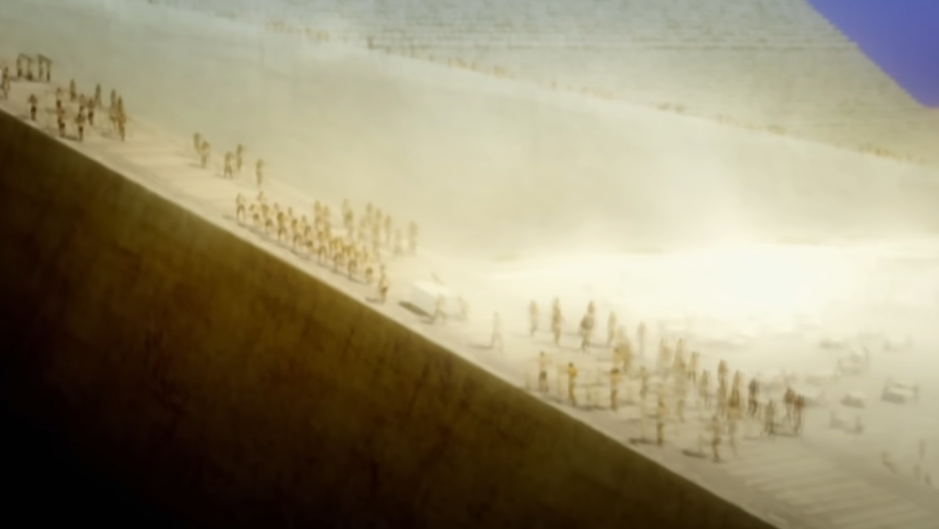 PBS, NOVA, Decoding the Great Pyramid (2019)
PBS, NOVA, Decoding the Great Pyramid (2019)
Ramp Basics
Research shows that any possible ramp cannot exceed a grade of eight percent. Anything steeper, and the workers couldn’t drag the stones up with the methods then in use. The ramp would also have to be wide enough to accommodate two-way traffic: a stone being dragged up the ramp would have to be able to move past an empty sled being brought down the ramp.
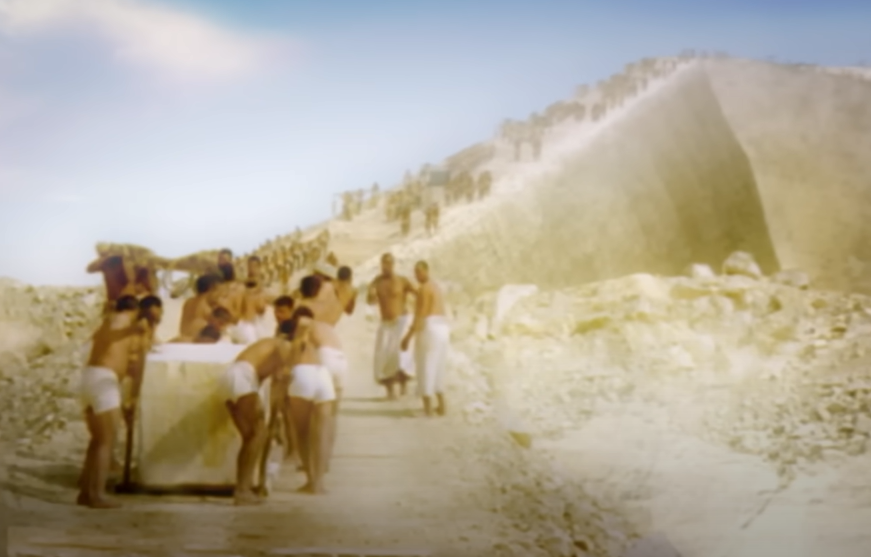 PBS, NOVA, Decoding the Great Pyramid (2019)
PBS, NOVA, Decoding the Great Pyramid (2019)
The Straight Ramp
The simplest ramp concept is the straight ramp. This ramp would have sloped up to each level as the pyramid was constructed. On paper, this idea certainly would have worked very well, especially for the lowest third of the pyramid. But the theory has serious problems.
 PBS, NOVA, Decoding the Great Pyramid (2019)
PBS, NOVA, Decoding the Great Pyramid (2019)
The Straight Ramp: Problems
To maintain a maximum slope of eight degrees, the straight ramp would have had to be a mile long to allow stones to be dragged to the pyramid’s top. Building such a ramp would have been a bigger engineering project than the pyramid itself, and there was not enough room for it either.
 PBS, NOVA, Decoding the Great Pyramid (2019)
PBS, NOVA, Decoding the Great Pyramid (2019)
The Zig-Zag Ramp
A ramp that zig-zagged progressively up one face of the pyramid has also been proposed, but it suffers from several drawbacks. Similar to the long straight ramp, a zig-zagging ramp would have to be supported on the 52-degree incline of a pyramid face. Such a ramp configuration would have stability problems, and that’s not even taking into account installing the smooth casing stones off such a structure.
 PBS, NOVA, Decoding the Great Pyramid (2019)
PBS, NOVA, Decoding the Great Pyramid (2019)
The Spiral Ramp
A narrow ramp steadily ascending around each face of the pyramid seems more workable than the zig-zag system on one face. It seems possible at first glance that a ramp could be set up and extended steadily up and around each face of the pyramid. But there are numerous problems with this model, too.
 PBS, NOVA, Decoding the Great Pyramid (2019)
PBS, NOVA, Decoding the Great Pyramid (2019)
The Spiral Ramp: Problems
The main problem of a spiral ramp is that the ramp itself would be covering the corners of the pyramid, making it impossible to measure back from newly completed work to ensure that everything is level. And, as with the zig-zag face ramp, it’s hard to imagine how any ramp could be supported on the steep incline of the pyramid face.
 PBS, NOVA, Decoding the Great Pyramid (2019)
PBS, NOVA, Decoding the Great Pyramid (2019)
The Biggest Problem
The biggest problem shared by all the competing ramp theories is a simple one: though remnants of ramps have been discovered elsewhere, and it’s an established fact that the Egyptians used ramps to move rock, there is no definite evidence of any ramp in the immediate vicinity of the pyramids.
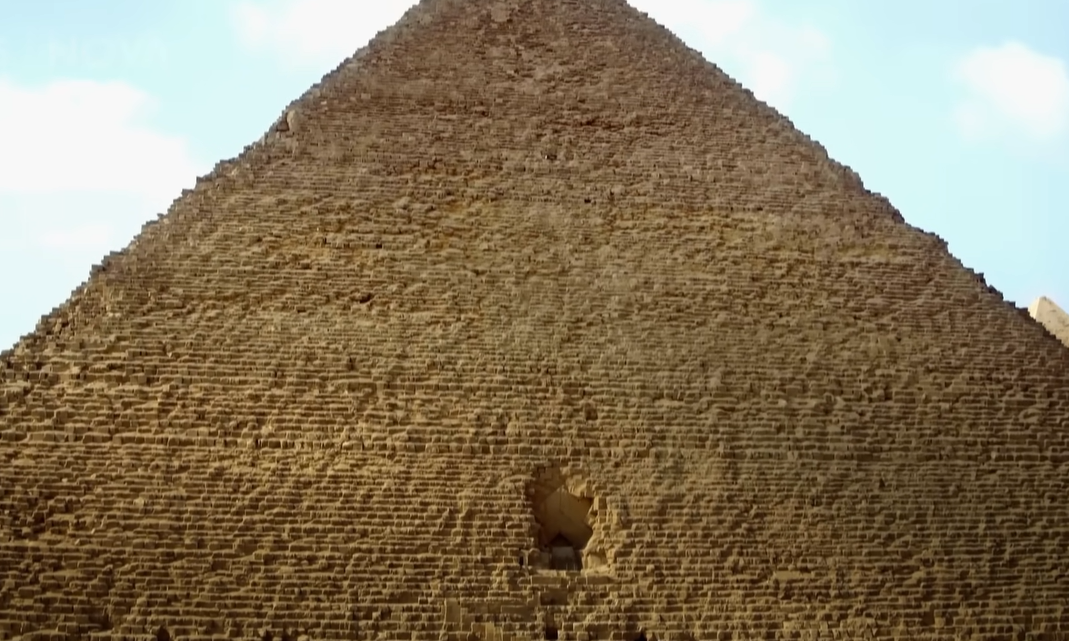 PBS, NOVA, Decoding the Great Pyramid (2019)
PBS, NOVA, Decoding the Great Pyramid (2019)
A Possible Solution
In 2005, French architect Jean-Pierre Houdin put forth a possible solution to the mystery. Houdin proposed a spiral ramp that ascended around the pyramid’s perimeter internal to the pyramid itself. An internal ramp would negate the need for additional materials, and explain why there is no sign of any external ramps.
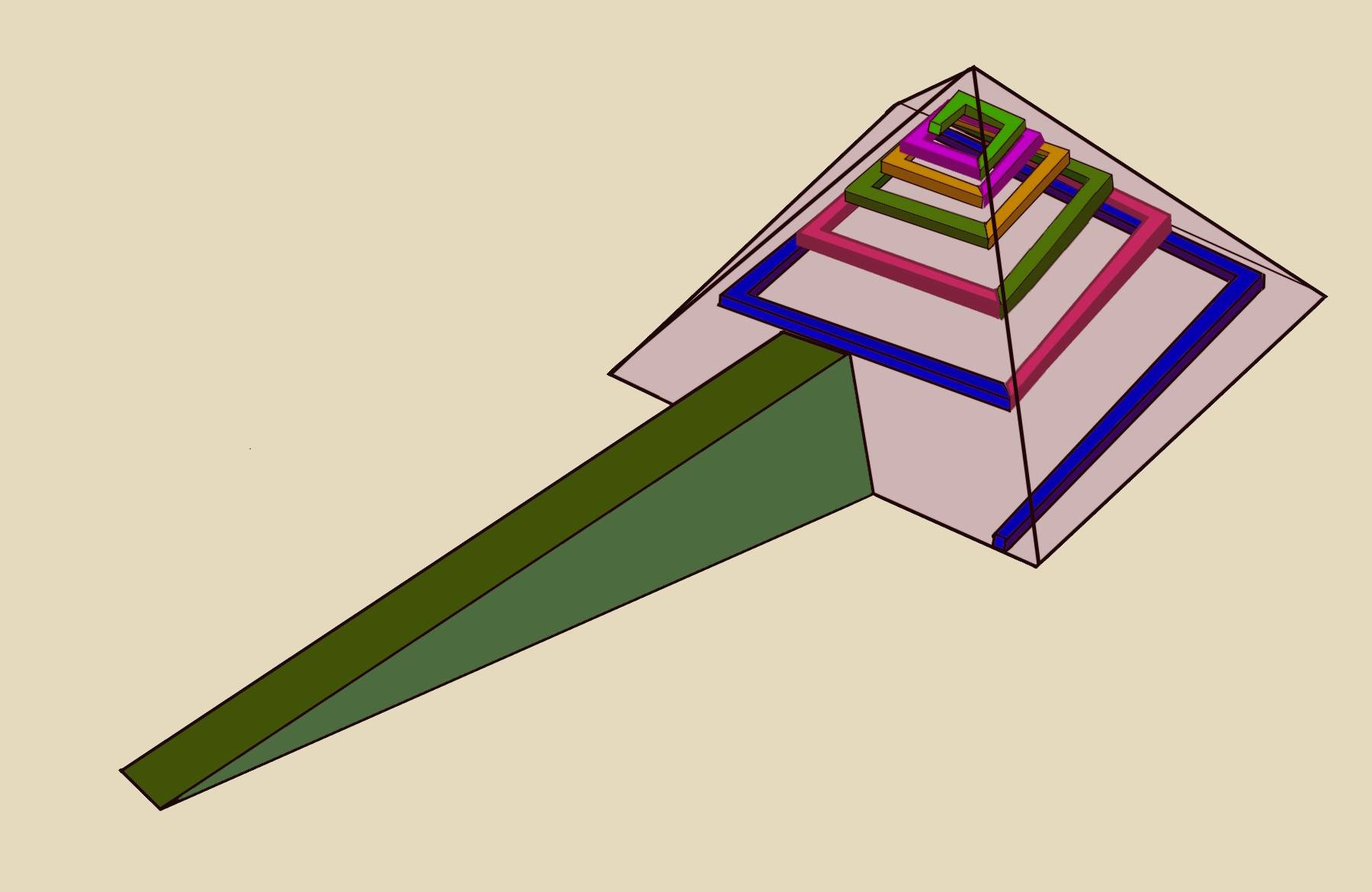 Rudolf.volz, CC BY-SA 4.0, Wikimedia Commons
Rudolf.volz, CC BY-SA 4.0, Wikimedia Commons
Building The Case For The Internal Ramp
Houdin proposed that a straight ramp was used to build the pyramid’s lower third; this simple approach would allow the bulk of the material to be moved up quickly, and accommodate the enormous granite blocks used for the Great Gallery and King’s Chamber. With these phases complete, the construction would shift to the internal ramp method. There are clues that indicate this was possible.
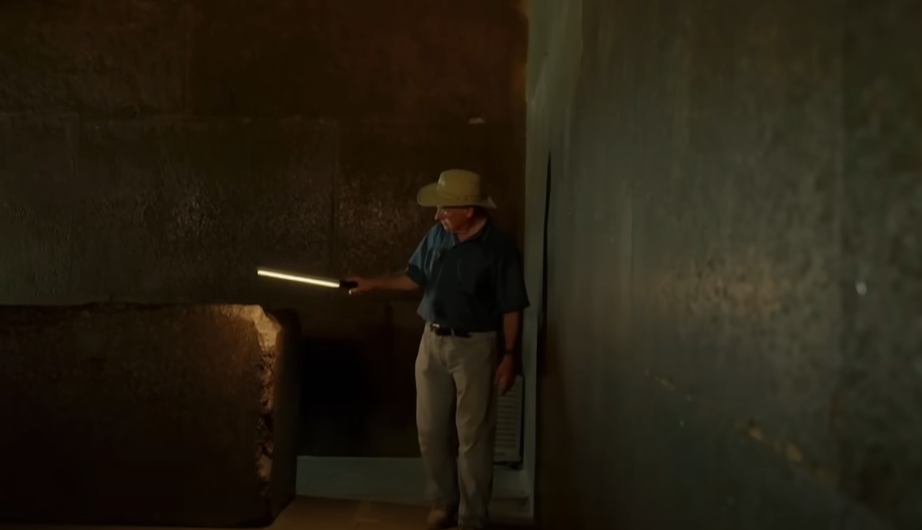 PBS, NOVA, Decoding the Great Pyramid (2019)
PBS, NOVA, Decoding the Great Pyramid (2019)
Physical Evidence Of An Internal Ramp
The best physical evidence of an internal ramp is the opening at about 270 feet up the southeast corner of the Great Pyramid. Inside this opening is an L-shaped room that Houdin believes would accommodate a lever for moving blocks around the corner. Further evidence is seen at the Sun Temple of Niuserre, whose small pyramid displays an internal ramp.
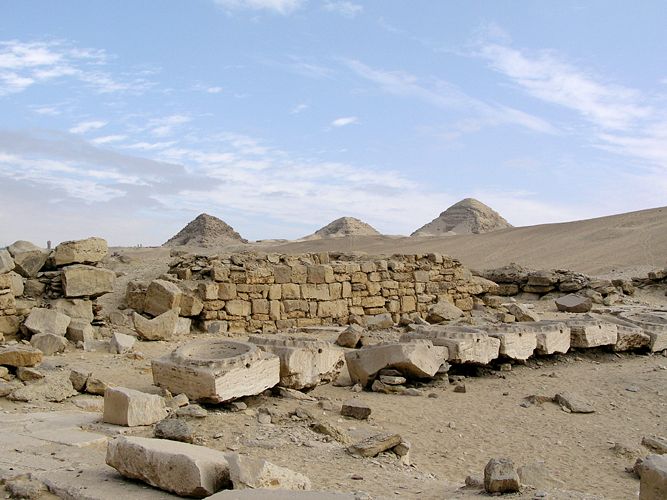 Jon Bodsworth, Wikimedia Commons
Jon Bodsworth, Wikimedia Commons
Discovery Of The Void
The study of the pyramids reached a major turning point in 2019 with the discovery of a large void inside the Great Pyramid, directly above the Grand Gallery. Found using new survey imaging methods, the void represents the first discovery inside the pyramid since the 1800s. But researchers still haven’t figured out the void’s purpose, or whether it supports Houdin’s internal ramp theory.
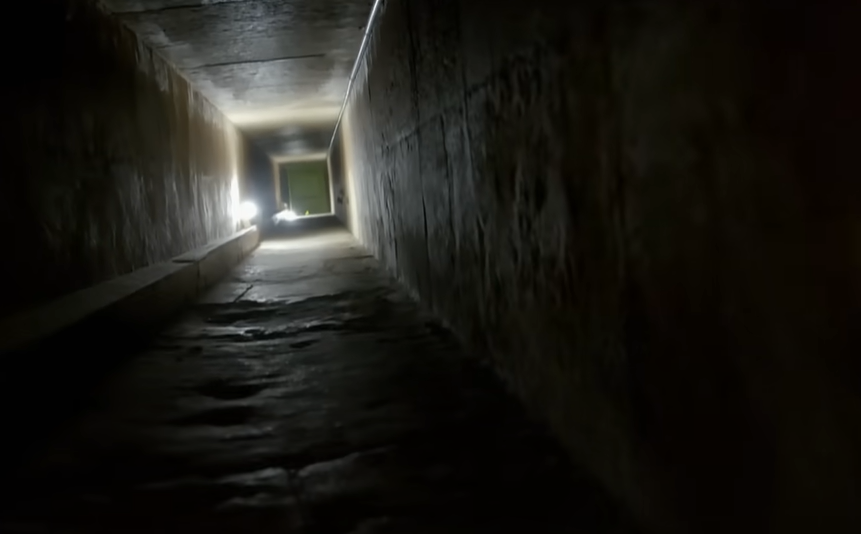 PBS, NOVA, Decoding the Great Pyramid (2019)
PBS, NOVA, Decoding the Great Pyramid (2019)
Far Out Theories
It’s unsettling to think that ancient people did things that we still can’t figure out, and that realization has led to some unusual theories over the years. Ideas about blocks with floats being pumped up water chutes; intervention by extraterrestrials; or even prehistoric giants are a few of the wilder ones. Almost all archaeologists think these theories are ludicrous.
The Mystery Endures
Even with all the theories of how the ancient Egyptians built the pyramids, nobody knows for sure exactly how they did it. As researchers unearth more artifacts, we may yet stumble on the elusive proof of the Egyptians’ ingenious building method. Though we’ve learned much in recent decades, the ultimate secret is still hidden in the sands of time.
 PBS, NOVA, Decoding the Great Pyramid (2019)
PBS, NOVA, Decoding the Great Pyramid (2019)

